|
1. A Merchant
1998 mixed media (CG) 27x32 cm
/ 10½x12½ in.
2. A Monk
1998 mixed media (CG) 27x32 cm / 10½x12½ in
3. he Knight's tale
1998 mixed media (CG) 27x32 cm / 10½x12½ in
4. The Knight's tale 2
1998 mixed media (CG) 27x32 cm / 10½x12½ in
5. The Knight's tale 3
1998 mixed media (CG) 27x32 cm / 10½x12½ in
6. The Knight's tale 4
1998 mixed media (CG) 27x32 cm / 10½x12½ in
7. The Miller's tale
1998 mixed media (CG) 27x32 cm / 10½x12½ in
8. The Reeve's tale
1998 mixed media (CG)
27x32 cm / 10½x12½ in

|
 |
1. |
 |
2. |
 |
3. |
 |
| |
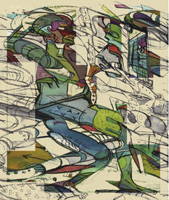 |
|
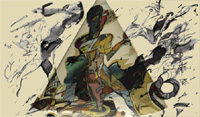 |
|
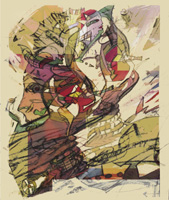 |
 |
 |
4. |
 |
5. |
 |
6. |
 |
| |
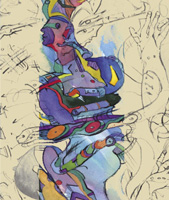 |
|
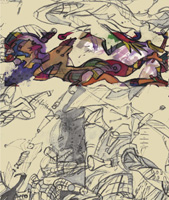 |
|
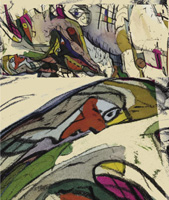 |
 |
 |
7. |
 |
. |
 |
8. |
 |
| |
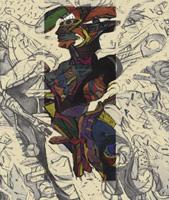 |
|
|
|
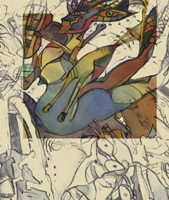 |
 |
 |
 |
 |
 |
 |
 |
 |
 |
While working, Russu
also changed his technique. In the early plates, fine nervously
vibrating lines crisscross the plate or run parallel. Over time,
these sensitive lines give way to single, strong cords, solidly
incised into the plate and solidly stacked on the paper,
surrounding the aquatinted areas like a wall. DECIPHERING THE
EROTICISM of the iconography was a challenge. One may even be
tempted to reread Boccaccio’s tales. Russu provides an image of
14th century Italian life by weaving certain artifacts into his
graphic tale. Checkerboard tablecloths, wine glasses, rigged
sailing vessels, horsemen and horsewomen, the headgear of the
period appear throughout the prints, in variations. Men and women
are barely humanoid, heads, torsi, limbs are floating in space,
disconnected, yet making sense and fitting together. Banquet
tables with checkered tablecloths are overturned, wine glasses
have fallen down, unbroken, the wine flowing out. A real orgy. One
head with a Cocteau-like profile is barely connected to a necktie
of the 20th century. Limbs terminate in stumps or clumps or
geometric finials. The anthropomorphic shapes in prehistoric caves
come to mind. RUSSU THE PRINTMAKER forces the viewer to return to
his prints and try to interpret the meaning of their iconography.
While they are immediately attractive visually, they ask for more
attention in the long run.
( Ingrid Rose, Curator
MoMA, New York )
Love, Sex, and Death – a
grand tour of 14th-century English mores and morals in poetry:
PILGRIMAGES /THE CANTERBURY TALES by Geoffrey Chaucer (1343 - 1400) in
141 graphics interpretation. Original English Language (cca.1300),
creative layout, 83 computer graphics, 58 drawings and paintings by
Petru Russu. On the Eve of a Pilgrimage, sometime in the waning years
of the 14th century, on a spring day in April 29 travelers from a
London Cheap side Inn set out on a pilgrimage to Canterbury Cathedral
to pay homage to the martyred St. Thomas a’ Becket. Among them, a
Knight, a Prioress, a Merchant, a Miller, a Monk, a Plowman, a Clerk,
the ever-entertaining oft-widowed Wife from Bath, and many others, are
challenged by the inn's Host to a competition: to while away their
morrow's journey by each telling a tale. On returning to London their
Host will then decided the best storyteller a luxurious meal on behalf
of that Pilgrim's fellows. |
|
|
|
|
